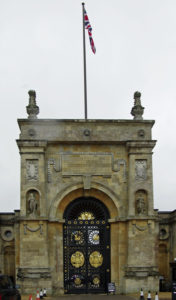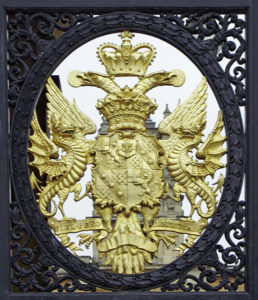Blenheim Palace is one of the great treasure houses of Britain and the only non royal or non episcopal palace in Britain. It was built for the First Duke of Marlborough from a grateful queen and nation
There is so much to describe that I have broken the review up into several different sections. This covers the history of the Palace and visiting. Part two describes the great hall, drawing rooms and dining room. Part three describes the state apartments, library and Churchill rooms. Part four describes the Chapel. Part 5 describes ‘The Untold Story’ exhibition on the first floor. The final part gives details about disabled access. The gardens are described separately.
John Churchill, First Duke of Marlborough gained a major victory against the French in the Spanish War of Succession at the Battle of Blenheim in 1704. As a reward from a grateful nation, Queen Anne granted him the park and ruined Royal Manor of Woodstock along with £240,000 to build a house to mark the occasion.
Sir John Vanburgh who had cut his teeth on castle Howard in Yorkshire, was chosen as architect assisted by Nicholas Hawksmoor. Grinling Gibbons and Edward Strong were chosen to produce the stone carvings that decorate both the inside and outside of the Palace. Sarah Churchill would rather have used Sir Christopher Wren and this difference of opinion led to problems and arguments. Vanbrugh regarded it very much as a royal commission designed as a monument to the Queen’s glory and a family home second, a source of contention between the Duchess and Vanbrugh. Sarah was also concerned about the cost and her high handed attempts to curb Vanbrugh’s grandiose ideas led to further problems between the two. Building took longer than planned and there was difficulty finding enough suitable stone locally. Quarries as far away as Plymouth and Ross -on-Wye were used, adding to the cost.
Sarah Churchill was a very close confident of Queen Anne. She was Mrs Freeman to the Queen’s Mrs Morley. When they fell out in 1710, Marlborough was dismissed from service to the queen. All state funding for the house ceased as the Queen’s decision to pay for the house had never been officially recorded. By 1712 all work stopped on the Palace with £45,000 still owing to the workmen. The Marlboroughs went abroad in voluntary exile between 1712-4, only returning after the death of Queen Anne. The Duke decided to complete the Palace at his own expense. Grinling Gibbons and Edward Strong had been paid only a third of what was owed to them and, as the Duke intended to pay them even less, they refused to to do any more work for him.
By 1716, Vanbrugh had also left in a rage as a result of differences between him and the Duchess over costs. James Moore, a cabinet maker and designer took over as Clerk of Works from Vanbrugh and Hawksmoor. Hawksmoor was only recalled after the Duke’s death for the Triumphal arch, library and some of the plaster ceilings.
Sir James Thornhill painted the ceiling in the Great Hall. He should also have painted those in the saloon and long library, but Sarah suspected him of over charging and employed the French artist Louis Laguerre to paint the ceiling and walls in the saloon. The long library ceilings were left unpainted.
The chapel was the last part of the house to be finished in 1733.
The Fourth Duke turned the Orangery into a theatre and asked Capability Brown to redesign estate with parkland and specimen trees. The River Glyme flowed through a very deep valley and was bridged by the Grand Bridge designed by Vanbrugh. Brown dammed the river forming the Great Lake and designed the cascade to hide the dam. He grassed over the forecourt and was also responsible for the Temple of Diana.
The Sixth Duke was responsible for moving the kitchens into the Palace rather than the kitchen court. It helped ensure food was hot when it reached the dining room.
The Ninth Duke inherited a nearly bankrupt title and married a wealthy American heiress, using her money to restore the Palace back to its former splendour. He bought tapestries and furniture to refill the depleted Palace. He was responsible for the gilded woodwork in the three staterooms, using craftsmen from Paris. The workmanship is of very high quality, although the overall effect in places is a bit over the top.
He repaved the forecourt, replanted the great avenue of elms leading from the Column of Victory to the Ditchley Gate and planted 465,000 trees around the park. He was also responsible for the water terrace gardens and the Italian gardens
The Palace was designed on a monumental scale and best seen from a distance with its central state apartments and wings containing the domestic quarters.
Visitors arrive at the EAST GATE which is the ceremonial entry, flying the standard when the Duke is in residence. It is a massive structure as the top half hides a cistern which supplied water to the private apartments and kitchens. A carved stone records Queen Anne’s gift to John and Sarah. The stone urns on the top are the work of Grinling Gibbons. The massive iron gates date from the C19th and were displayed at the Great Exhibition in 1851. They have the gilded double headed eagle crest of the Churchill family.
This lead through into the EAST COURT (or Kitchen Court) with the orangery on one side. The estate and audit offices were originally the kitchens and the laundry was also here. A gateway under the CLOCK TOWER leads to the GREAT COURT. The clock was designed by Langley Bradley and the three faces were designed to be seen from around the estate. The sculptures of the lions savaging the ‘protesting cocks of France’ are by Grinling Gibbons.
At the centre are the state apartments reached by a flight of stairs. The Marlborough Coat of Arms is above the entrance. The stone glows golden in the sunshine.
The two wings contain the domestic quarters and were intended by Vanburgh to be symmetrical. The east side was finished first and this was where John and Sarah had their private apartments. The west court was never finished.
The ‘back side’ of the palace away from the main entrance and seen from the south lawn, is much plainer and less flamboyant.
VISITING
Visiting the house and gardens is expensive at £24.90 or £19.90 for concessions (but not at weekends or bank holidays). This gives entry to the state rooms, Churchill exhibition and the gardens. Monday to Saturdays there are guided tour of the state rooms. You can also pay extra for a guided tour of the private quarters or upstairs downstairs tours. Buggy tours of the estate are also extra as is the ride on the train to the Pleasure Grounds in the old walled garden. The ticket can be converted to a free annual pass.
The park and gardens ticket is £14.90 or £10.90 for concessions. This again can be converted to an annual pass and gives access to the parkland, formal gardens, pleasure gardens as well as the Churchill’s Destiny Exhibition and the Indoor Cinema.
There is a lot to see and you need to allow several hours for a visit and preferably all day. The post code is OX20 1PP and the grid reference for the entrance is SP 448166.
All the information and my pictures are “here.”:http://wasleys.org.uk/eleanor/stately_homes_castles/england/westmidlands/blenheim/index.html









